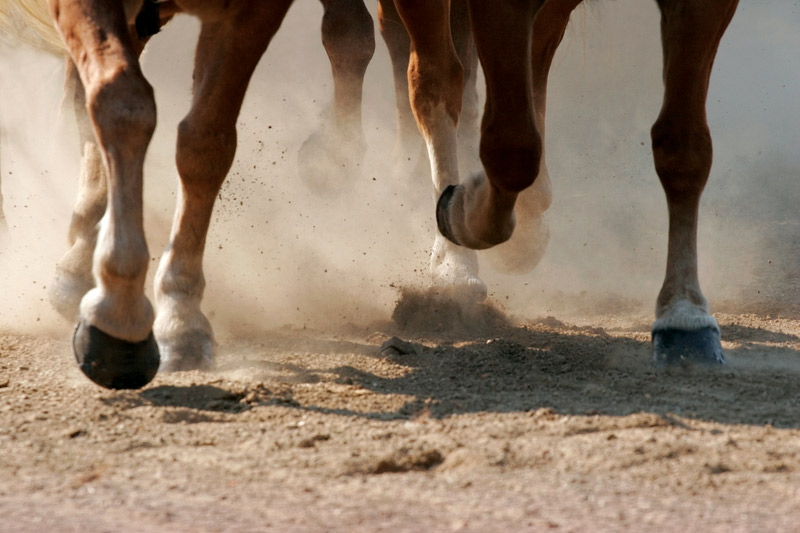Do your horse’s hooves hit one another when he’s moving forward? Interference is a manmade problem that can be corrected using a natural hoofcare approach.
No one likes interference. In terms of equine health, interference refers to the hooves colliding with one another or with the legs above the hoof. There are as many types of interference as there are purported causes. The two most common causes are forging (over-reaching hind to front), and clipping (aka brushing, wherein the left and right feet strike each other).
There are countless reasons given for these and other types of interference, ranging from the horse’s conformation to poor riding skills, lameness and the type of work the horse must endure. Accordingly, remedies may entail “corrective shoeing” (e.g. for forging, you “roll the toe” of the front shoe and “square the toe” of the hind shoe), using “bell boots”, changing bits or the saddle to “correct” the horse’s frame and forward motion, and so on.
A Different Take
NHC practitioners like myself see interference through a somewhat different lens and, not surprisingly, treat the matter differently (if less conventionally) than described above.
First, let’s begin with a different definition of interference, then move to cause and elimination. From the NHC perspective, interference is not at all natural to the horse. It is entirely “manmade”, and correctable when we better understand the cause and how to resolve the issue.
Natural Gaits
I define interference as an obstruction of the horse’s natural gaits. Of course, you must know and appreciate what natural gaits are before you can address the problem. Fortunately this is not hard to do and, for the sake of discussion, I will assume the horse is not clinically lame. Follow these simple steps:
1 Make sure the hooves are naturally shaped; this will entail the services of a professional NHC practitioner.
2 Turn the horse loose with other horses, unbridled/ unsaddled and without a rider, in a large turnout so they can engage each other vigorously in “horse play”. This will give you a moving picture of the horse’s natural gaits. Spend time studying them. In my many years since giving up shoeing and becoming a dedicated NHC practitioner, I have not witnessed a single instance of interference under these circumstances. The horse’s conformation and his temperament, regardless of what they are, will make no difference.
Classical Horsemanship
If your horse is interfering, try the above two steps. If he stops interfering then it is simply a matter of addressing your horsemanship. I do not recommend trying to analyze the type of interference, nor do I recommend conventional remedies. Instead, I recommend the tenets of classical horsemanship, which parallel my own construct of natural horsemanship based on the wild horse model. As a lead in to the subject, I recommend highly Alois Podhajsky’s Complete Training of Horse and Rider.
A Natural Resolution
The problem with interference, if not corrected the natural way, is that it invariably leads to lameness. This is enough to bring riding to a halt for most horse owners. But where does this leave the horse? Hopefully not devastated.
Particularly extreme (e.g. competitive) riding, unnatural boarding conditions, mechanically obstructive shoeing and unnatural trimming methods cause the most damage and are of the greatest concern.
Interference need not plague any horse. But it is up to you to use nature’s way to get him going again, sound and happy!
Jaime Jackson is a 35-year veteran hoof care professional, lecturer, author, researcher and noted expert on wild and domestic horse hooves. In the early 2000s, Jaime created the American Association of Natural Hoof Care Practitioners, now called the Association for the Advancement of Natural Horse Care Practices (aanhcp.net). He has published five books – The Natural Horse: Lessons from the Wild; The Horse Owner’s Guide to Natural Hoof Care; Founder: Prevention & Healing the Natural Way; Paddock Paradise: A Guide to Natural Horse Boarding and The Natural Trim (formerly the Official Trimming Guidelines of the AANHCP). Jaime resides in central California.







